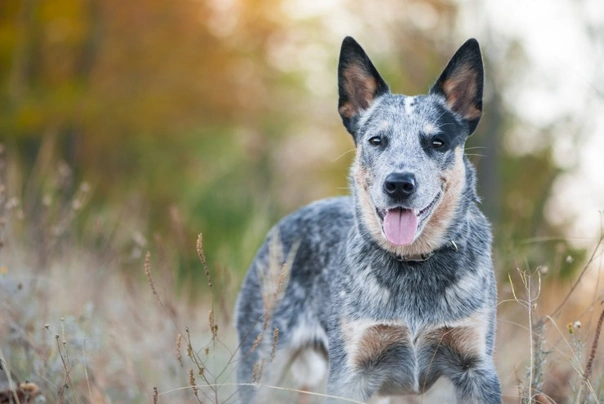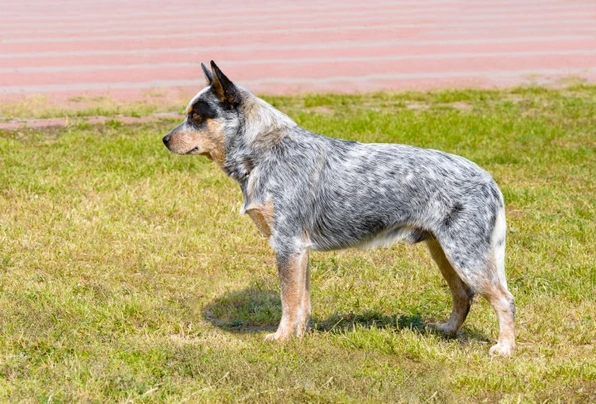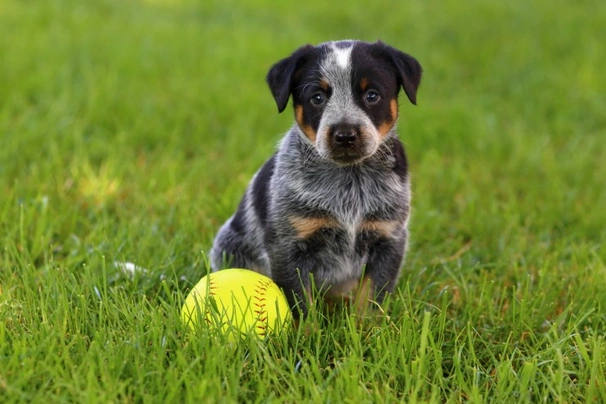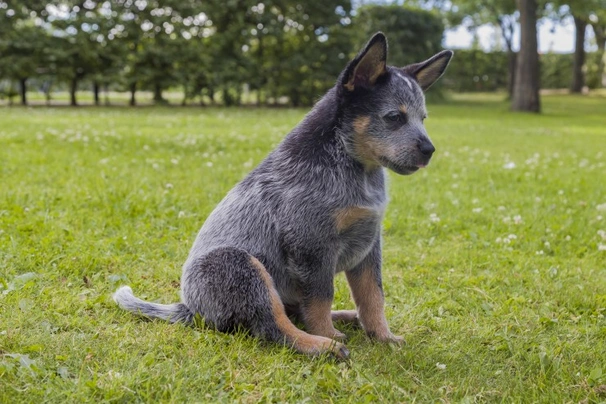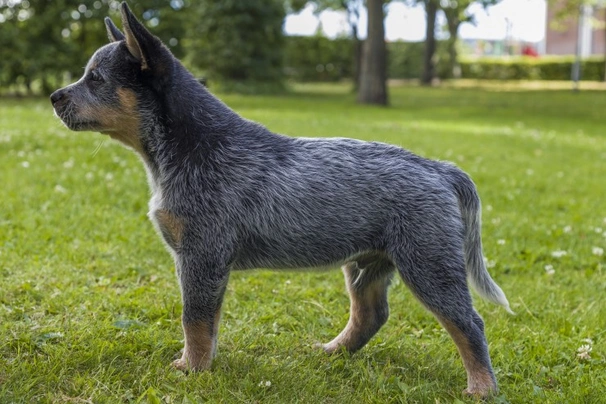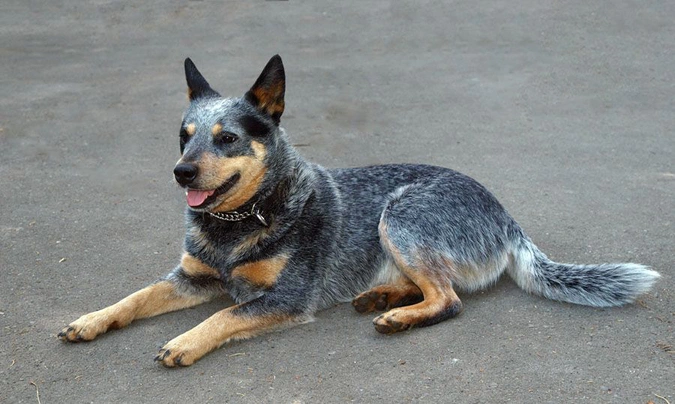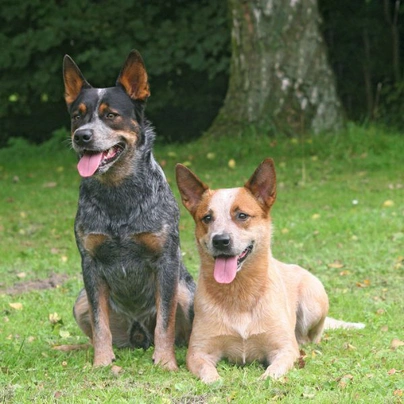Australian Cattle Dog
Pros
Cons
Introduction of the Australian Cattle Dog
Australian Cattle dogs as their name suggests are native to Australia where they are highly prized as working dogs thanks to their strength of character stamina and ability to work for long periods of time. Over the years these attractive dogs have fast become a popular choice in a home environment not only in Australia but here in England and other parts of the world too.
They are often called Heelers because of the way they herd livestock which is by nipping at their heels. They can be wary around strangers and protective of their "family" they are loyal and highly intelligent dogs that boast an implicit devotion to any jobs they are asked to do. Although Australian Cattle Dogs make wonderful family pets they are much better suited to people who live in the country and who lead active outdoor lives.
History of the Australian Cattle Dog
Australian Cattle Dogs have been around since the eighteen hundred’s in their native Australia but only arrived on British shores in 1979 when John and Mary Holmes imported the very first dog from Australia. However two puppies were also imported to the UK at around the same time by Malcom Dudding and it is these dogs that boast being the foundation stock of the ACD we see in the UK today.
The breed was developed during the 1800’s by ranchers because herding dogs they took over with them or which they imported could not cope with the extreme conditions and the type of cattle they had to work. ACDs are the result of careful albeit intensive crossbreeding in their native Australia when it was found that dogs bought over from other countries were not up to herding and controlling cattle when they were taken to market. This involved long treks across difficult terrains which imported dogs were just not up to.
The dogs that were used to create the breed were Dingos Kelpies Dalmatians and Bull Terriers but as previously mentioned ACDs have been around since the mid eighteen nineties when dogs were needed on ranches in the outback. A farmer called Thomas S Hall crossed a Dingo with two blue merle Collies he had imported from the UK. At the time the dogs he produced were called Hall's Heelers Blue Heelers Red Heelers or Queensland Heelers.
The first breed standard was established in 1903 after which time more records were kept of these dogs by a man called Robert Kaleski who also wrote many books on the breed. Being very independent thinkers ACDs soon earned themselves the reputation of being highly intelligent and capable of working on their own without the need to always rely on people to tell them what to do when herding livestock over vast distances.
Today the Australian Cattle Dog is still highly prized and regarded as a very skilled working dog in their native Australia but they have also made a name with people all over the world for being wonderful companions and family pets as well as working dogs.
Interesting facts about the breed
- Is the Australian Cattle Dog a vulnerable breed? No they are extremely popular in their native Australia and in other southern hemisphere countries. The breed has also found a fanbase in the UK although finding a well-bred pedigree ACD puppy can prove challenging with very few puppies being registered with the Kennel Club every year
- The Australian Cattle Dog is one of the breeds that boasts having a long lifespan with a dog called Bluey having lived to the age of 29 years and 5 months. He worked both sheep and cattle for around 20 years before he retired
- Australian Cattle Dogs are much better suited to a working or semi-working environment and therefore much happier when they are given something to do
- Their desire to “nip” at the heels of an animal (or person) to get them to move along is a trait that is deeply embedded in a dog’s psyche and as such it needs to be gently nipped in the bud
- Traditionally an Australian Cattle Dog’s tail was always docked but since the law banning the procedure came into effect in 2007 tail docking is now illegal with the exception being for some working breeds and if a dog suffers from some sort of health issue that requires their tails to be docked. The procedure must be agreed and authorised before being performed by a qualified vet
Appearance of the Australian Cattle Dog
Height at the withers: Males 46–51 cm Females 43–48 cm
Average Weight: Males 15–22 kg Females 15–22 kg
Australian Cattle Dogs are strong and compact giving the appearance of having great balance and a lot of power. Their heads are broad and nicely proportioned in relation to their body with a slight curve in between a dog's ears. Their cheeks are noticeably muscular and they boast strong jaws and muzzles that are neither too short or too long with a black nose.
Eyes are an oval shape and dark brown in colour with dogs boasting an intelligent calm look. However ACDs are known to have a bit of a "suspicious" glint in their eyes especially when around strangers. Their ears are neat and broader at the base which dogs hold pricked and they are set wide apart on a dog's head. They boast a clean jaw line and a perfect scissor bite where their upper teeth neatly overlap their lower ones.
An Australian Cattle Dog's neck is muscular very strong looking and their forequarters are also powerful with well laid back sloping shoulders. Legs are strong and well-muscled. As previously mentioned the ACD is a compact looking dog and they boast a strong body with a nice level topline over a well sprung rib cage. Their chests are deep and muscular again showing a lot of power and strength.
Hindquarters like their forequarters are strong broad and well-muscled and dogs have strong back legs with well-developed thighs. Their feet are round with short well arched toes and hard tough pads perfect for driving livestock over long distances. Their tails are set low and hang with a slight curve in them although when dogs are excited or alert they hold their tails slightly raised but never too high.
When it comes to their coat Australian Cattle Dogs boast smooth double coats with a shorter and much denser undercoat. Their top coat is coarser and extremely weather resistant. The hair on their underbody and back of the legs as well as around their neck is slightly longer but the hair on a dog's head the front of their legs and feet is neat and short. Acceptable coat colours for Kennel Club registration are as follows:
- Blue
- Blue & Tan
- Blue Black & Tan
- Blue Speckled
- Red
- Red & Tan
- Red Speckled
It is worth noting that acceptable breed colours for Kennel Club registration are not always the same as those set out in a dog’s breed standard.
Gait/movement
When an Australian Cattle Dog moves they do so with a free tireless and supple gait showing a tremendous amount of drive from behind. ACDs are very quick off the mark and able to turn on a sixpence without losing balance or momentum. When they stand they stand “square” but when they move an ACD’s legs converge.
Faults
The Kennel Club frowns on any exaggerations or departures from the breed standard and would judge the faults on how much they affect a dog's overall health and wellbeing as well as their ability to perform.
Males should have both testicles fully descended into their scrotums and it is worth noting that a dog can be a little lighter or heavier as well as slightly taller or shorter than set out in the Kennel Club breed standard which is only given as a guideline.
Temperament of the Australian Cattle Dog
Australian Cattle Dogs are renowned for both their courage and their intelligence. They are also known to be highly suspicious of people they don't know but they are tremendously loyal and protective of their owners their family and property. As working dogs they are totally devoted to the job they were bred to do which is to herd livestock over great distances when asked to.
They are also devoted and trustworthy family dogs known to be as kind as they are tough. The ACD is one of the more "natural" breeds and therefore they boast very few hereditary or congenital health issues that are so often seen in other pure breeds. Because they are so intelligent the Australian Cattle Dog excels at many canine sports which includes agility obedience and other canine sporting activities. They literally thrive on the partnership they form with their owners when taking part in any classes or competitions. However they are high energy dogs and therefore they need to be given the right amount of exercise and mental stimulation to be truly happy well-rounded dogs. As such they are not the best choice for first time dog owners but they do well with people who are used to handling and training such intelligent high energy characters.
Another thing to bear in mind is that ACDs were bred to nip and as such this is something they naturally do especially when excited about anything. They are also known to "nip" children when they get too boisterous. These dogs also need to know their place in the "pack" which means they must be given the right sort of direction and training or they would end up getting the upper hand which usually results in them becoming unruly stubborn dogs that are hard to handle.
Australian Cattle Dogs are definitely not couch potatoes and would not be a good choice for people who lead more sedentary lives. They do not like being left to their own devices either preferring to spend all their time at their owner's side. They are however the perfect dog for families and people who work outdoors or who spend as much of their time as possible in the great outdoors.
Australian Cattle Dogs also boast one of the longest life spans with one dog called "Bluey" having worked cattle and sheep for 20 years before retiring. He died when he was over 29 years old back in 1939 which in short means that if you decide to share your existence with an Australian Cattle Dog they will be a constant companion for a very long time if well cared for.
Are they a good choice for first time owners?
Australian Cattle Dogs are not a good choice for first time dog owners because they need to be handled trained and socialised by people who are familiar with the specific needs of a highly intelligent energetic and devoted dog.
What about prey drive?
ACDs have a high prey drive and will happily chase anything that runs away or which they deem to be threatening. The good news is that because they are so intelligent Australian Cattle Dogs can be taught the “leave it” command which they generally listen to and obey without a second thought.
What about playfulness?
Australian Cattle Dogs have a very playful side to their natures and being so intelligent they quickly learn how to please an owner. They love playing interactive games and because they are so amenable to getting things right as previously mentioned they excel at all sorts of canine sports which they thoroughly enjoy.
What about adaptability?
Australian Cattle Dogs do best when living with people who lead active outdoor lives. They benefit from having a large secure back garden they can safely roam whenever possible too so that a dog can really let off steam bearing in mind that fencing must be ultra-secure to keep an ACD in.
What about separation anxiety?
ACDs form strong ties with their families and although they can be “independent thinkers” they are never very happy when they find themselves left on their own for longer periods of time. They are better suited to people who either work from home or in households where one person stays at home when everyone else is out so that a dog never has to spend too much time on their own which could see them suffering from separation anxiety. This can lead to them being destructive around the home which is a dog's way of relieving any stress they are feeling and a way to keep themselves entertained.
What about excessive barking?
Australian Cattle Dogs are not known to be “barkers” and will only generally voice an opinion when they feel it necessary to do so which includes when there are strangers about or when something they don’t like is going on in their “territory” bearing in mind that they are territorial and protective by nature.
Do Australian Cattle Dogs like water?
Most ACDs love swimming and will take to the water whenever they can more especially when the weather is hot. However if anyone who owns a dog that does not like water should never force them to go in because it would just end up scaring them. With this said care should always be taken when walking a dog off the lead anywhere near more dangerous watercourses just in case a dog decides to leap in and then needs rescuing because they cannot get out of the water on their own and need rescuing.
Are Australian Cattle Dogs good watchdogs?
Australian Cattle Dogs are protective of their environments and their families which means they are extremely alert watchdogs and would always be quick off the mark to let an owner know when something is amiss. However rarely would an ACD show aggression towards someone unless they feel threatened by the person that is.
Intelligence / Trainability of the Australian Cattle Dog
Australian Cattle Dogs are highly intelligent with the added bonus of them being eager to learn new things which is why they are among the most popular working dogs in their native Australia and in other parts of the world. They are best trained and handled by someone who is familiar with the breed or this type of active high-energy dog and would not be the best choice for people who have never owned a dog in the past.
An Australian Cattle Dog's training needs to start early and puppies must be well socialised from a young age for them to be more confident outgoing characters. These dogs can be quite timid when they reach their adolescence and therefore need to be handled gently and fairly at this vulnerable time. Their training also needs to be consistent throughout their lives. They are happiest and more responsive when they know their place in pack and when they are given the right sort of direction and guidance.
Like all puppies Australian Cattle Dog puppies are extremely cute which means it is all too easy to spoil them when they first arrive in their new homes. However they are also amazingly smart and therefore they pick up things quickly and this includes bad behaviours. As such as soon as a puppy is nicely settled owners must start out as they mean to go on which means laying down rules and boundaries so that an ACD puppy understands what an owner expects of them. It also helps establish the right “pecking order” and who is the alpha dog in a household. The first commands a puppy should be taught are as follows:
- Come
- Sit
- Stay
- Heel
- Quiet
- Leave it
- Down
- Bed
Children and other
Australian Cattle Dogs are generally good around kids of all ages although adult supervision is always advisable especially with puppies because it's in their nature to "nip" which often happens when they are excited about things and this includes when children start running about or get too boisterous.
ACDs are known to be extremely territorial and therefore they can show aggression towards other dogs no matter what size they happen to be. It's important for them to be introduced to new pets and animals slowly and carefully although if a dog has grown up with another pet they generally tolerate having them around.
Health of the Australian Cattle Dog
The average life expectancy of an Australian Cattle Dog is between 12 and 14 years when properly cared for and fed an appropriate good quality well-balanced diet to suit their ages.
Known to be a robust and healthy dog the Australian Cattle Dog does however have quite a small gene pool and as a result they are prone to suffer from a few hereditary conditions which are worth knowing about if you’ve decided to share your home with one of these high energy dogs. The health issues most commonly associated with the breed includes the following:
- Progressive Retinal Atrophy (PRA) - DNA test available
- Hip dysplasia – dogs should be hip scored
- Elbow dysplasia – dogs should be elbow tested
- Congenital deafness – dogs should be BAER tested
What about vaccinations?
ACD puppies would have been given their initial vaccinations before being sold but it is up to their new owners to make sure they have their follow-up shots in a timely manner with the vaccination schedule for puppies being as follows:
- 10 -12 weeks old bearing in mind that a puppy would not have full protection straight away but would be fully protected 2 weeks after they have had their second vaccination
There has been a lot of discussion about the need for dogs to have boosters. As such it's best to talk to a vet before making a final decision on whether a dog should continue to have annual vaccinations which are known as boosters.
What about spaying and neutering?
A lot of vets these days recommend waiting until dogs are slightly older before spaying and neutering them which means they are more mature before undergoing the procedures. As such they advise neutering males and spaying females when they are between the ages of 6 to 9 months old and sometimes even when a dog is 12 months old.
Other vets recommend spaying and neutering dogs when they are 6 months old but never any earlier unless for medical reasons. With this said many breeds are different and it is always advisable to discuss things with a vet and then follow their advice on when a dog should be spayed or neutered.
What about obesity problems?
Like other breeds an ACD can gain weight after they have been spayed or neutered and it's important to keep an eye on a dog's waistline just in case they do. If a dog starts to put on weight it's important to adjust their daily calorie intake and to up the amount of exercise they are given. Older dogs too are more prone to gaining weight and again it's essential they be fed and exercised accordingly because obesity can shorten a dog's life by several years. The reason being that it puts a lot of extra strain on a dog's internal organs including the heart which could prove fatal. It’s also worth noting that an Australian Cattle Dog can live on “air” and as such great care must be taken as to how much a dog is fed daily.
What about allergies?
Some ACDs are prone to suffering from allergies and it's important for a dog to see a vet sooner rather than later if one flares up. Allergies can be notoriously hard to clear up and finding the triggers can be challenging. With this said a vet would be able to make a dog with an allergy more comfortable while they try to find out the triggers which could include the following:
- Certain dog foods that contain high levels of cereal and other grain type fillers
- Airborne pollens
- Dust mites
- Environment
- Flea and tick bites
- Chemicals found in everyday household cleaning products
Participating in health schemes
All responsible Australian Cattle Dog breeders would ensure that their stud dogs are tested for known hereditary and congenital health issues known to affect the breed by using the following schemes:
- DNA test - prcd-PRA
- BVA/KC Hip Dysplasia Scheme
- BVA/KC Elbow Dysplasia Scheme
- BVA/KC/ISDS Eye Scheme
- BAER Testing (deafness) through the Animal Health Trust (AHT)
What about breed specific breeding restrictions?
Apart from the standard breeding restrictions for all Kennel Club recognised breeds there are no other breed specific breeding restrictions in place for the Australian Cattle Dog.
What about Assured Breeder Requirements?
It is mandatory for all Kennel Club Assured breeders to use the following test on their dogs and other breeders are strongly advised to follow suit:
The Kennel Club also strongly recommends that all breeders use the following test on their dogs before using them for breeding purposes:
Caring for the Australian Cattle Dog
As with any other breed Australian Cattle Dogs need to be groomed on a regular basis to make sure their coats and skin are kept in top condition. They also need to be given regular daily exercise to ensure they remain fit. Unlike many other breeds they need a lot more in the way of mental stimulation and physical exercise because these dogs are definitely not couch potatoes. On top of this an ACD needs to be fed good quality food that meets all their nutritional needs throughout their lives.
Caring for an Australian Cattle Dog puppy
ACD puppies are boisterous and full of life which means it's essential for homes and gardens to be puppy-proofed well in advance of their arrival. A responsible breeder would have well socialised their puppies which always leads to more outgoing confident and friendly dogs right from the word go. With this said any puppy is going to feel vulnerable when they leave their mother and littermates which must be taken into account. The longer a puppy can remain with their mother the better although it should never be for too long either.
It's best to pick a puppy up when people are going to be around for the first week or so which is the time needed for a puppy to settle in. Puppy-proofing the home and garden means putting away any tools and other implements that a boisterous puppy might injure themselves on. Electric wires and cables must be put out of their reach because puppies love chewing on things. Toxic plants should be removed from flowerbeds and the home too.
Puppies need to sleep a lot to grow and develop as they should which means setting up a quiet area that's not too out of the way means they can retreat to it when they want to nap and it's important not to disturb them when they are sleeping. It's also a good idea to keep "playtime" nice and calm inside the house and to have a more active "playtime" outside in the garden which means puppies quickly learn to be less boisterous when they are inside.
The documentation a breeder provides for a puppy must have all the details of their worming date and the product used as well as the information relating to their microchip. It is essential for puppies to be wormed again keeping to a schedule which is as follows:
- Puppies should be wormed at 6 months old
- They need to be wormed again when they are 8 months old
- Puppies should be wormed when they are 10 months old
- They need to be wormed when they are 12 months old
Things you'll need for your puppy
There are certain items that new owners need to already have in the home prior to bringing a new puppy home. It's often a good idea to restrict how much space a puppy plays in more especially when you can't keep an eye on what they get up to bearing in mind that puppies are often quite boisterous which means investing in puppy gates or a large enough playpen that allows a puppy the room to express themselves while keeping them safe too. The items needed are therefore as follows:
- Good quality puppy or baby gates to fit on doors
- A good well-made playpen that's large enough for a puppy to play in so they can really express themselves as puppies like to do
- Lots of well-made toys which must include good quality chews suitable for puppies to gnaw on bearing in mind that a puppy will start teething anything from when they are 3 to 8 months old
- Good quality feed and water bowls which ideally should be ceramic rather than plastic or metal
- A grooming glove
- A slicker brush or soft bristle brush
- Dog specific toothpaste and a toothbrush
- Scissors with rounded ends
- Nail clippers
- Puppy shampoo and conditioner which must be specifically formulated for use on dogs
- A well-made dog collar or harness
- A couple of strong dog leads
- A well-made dog bed that's not too small or too big
- A well-made dog crate for use in the car and in the home that's large enough for a puppy to move around in
- Baby blankets to put in your puppy's crate and in their beds for when they want to nap or go to sleep at night
Keeping the noise down
All puppies are sensitive to noise including ACD puppies. It's important to keep the noise levels down when a new puppy arrives in the home. TVs and music should not be played too loud which could end up stressing a small puppy out which could end up making them withdrawn timid and shy.
Keeping vet appointments
As previously mentioned Australian Cattle Dog puppies would have been given their first vaccinations by the breeders but they must have their follow up shots which is up to their new owners to organise. The vaccination schedule for puppies is as follows:
- 10 -12 weeks old bearing in mind that a puppy would not have full protection straight away but would only be fully protected 2 weeks after they have had their second vaccination
When it comes to boosters it's best to discuss these with a vet because there is a lot of debate about whether a dog really needs them after a certain time. However if a dog ever needed to go into kennels their vaccinations would need to be fully up to date.
What about older Australian Cattle Dogs when they reach their senior years?
Older ACDs need lots of special care because as they reach their golden years they are more at risk of developing certain health concerns. Physically a dog's muzzle may start to go grey but there will be other noticeable changes too which includes the following:
- Coats become coarser
- A loss of muscle tone
- ACDs can either become overweight or underweight
- They have reduced strength and stamina
- Older dogs have difficulty regulating their body temperature
- They often develop arthritis
- Immune systems do not work as efficiently as they once did which means dogs are more susceptible to infections
- Older dogs change mentally too which means their response time tends to be slower as such they develop the following:
- They respond less to external stimuli due to impaired vision or hearing
- They tend to be a little pickier about their food
- They have a lower pain threshold
- Become intolerant of any change
- Often an older dog can feel disorientated
Living with an Australian Cattle Dog in their golden years means taking on a few more responsibilities but these are easily managed and should include looking at their diet the amount of exercise they are given how often their dog beds need changing and keeping an eye on the condition of their teeth.
Older ACDs need to be fed a good quality diet that meets their needs at this stage of their lives all the while keeping a close eye on a dog's weight. A rough feeding guide for older dogs is as follows bearing in mind they should be fed highly digestible food that does not contain any additives:
- Protein content should be anything from 14 – 21%
- Fat content should be less than 10%
- Fibre content should be less than 4%
- Calcium content should be 0.5 – 0.8%
- Phosphorous content should be 0.4 – 0.7%
- Sodium content should be 0.2 – 0.4%
Older ACDs don't need to be given the same amount of daily exercise as a younger dog but they still need the right amount of physical activity to maintain muscle tone and to prevent a dog from putting on too much weight. All dogs need access to fresh clean water and this is especially true of older dogs when they reach their golden years because they are more at risk of developing kidney disorders.
Grooming of the Australian Cattle Dog
Australian Cattle Dogs are not high maintenance in the grooming department all thanks to their short smooth coats. However just like other breeds they do shed more during the Spring and then again in the Autumn which is when a dog needs more frequent grooming to keep their coats tidy and any shed hair off the furniture.
They don't have that typical "doggy" smell either and they don't need frequent bathing unless absolutely necessary which is just another reason why they have become such popular companion dogs and family pets outside of their native Australia.
Exercise of the Australian Cattle Dog
ACDs need to be given a tremendous amount of daily exercise and ideally they do better living with people who work from home and who have outdoor jobs. They are also extremely intelligent alert characters which means they need to be given lots of mental stimulation to keep them happy and well-balanced or they will get bored which could result in a dog becoming unruly and difficult to manage.
Feeding of the Australian Cattle Dog
Australian Cattle Dogs are extremely hardy characters that can live on air which is why it's important to keep an eye on their weight. However these dogs need to be fed a good quality well-balanced diet that suits the different stages of their lives to remain fit and healthy.
If you have decided to get a puppy from a breeder they would provide you with a feeding schedule and it's important to stick to it for the first few weeks after bringing a puppy home. You can change their diet when the time is right but this needs to be done very gradually and carefully over a few weeks to make sure puppy doesn’t suffer any tummy upsets. If they do it’s important to put them back on their original diet and to discuss things with the vet before trying to change their diet again.
It's also important for puppies to be fed at least 3 to 4 times a day to begin with but you can start feeding them the same amount of food twice a day when they are around 4 months old always keeping an eye on things to make sure a young dog can cope with the change in their feeding routine.
Feeding guide for an Australian Cattle Dog puppy
Puppies need to be fed a highly nutritious good quality diet for them to develop and grow as they should. As a rough guide an ACD puppy can be fed the following amounts every day making sure their meals are evenly spread out throughout the day and it's best to feed them 3 or 4 times a day:
- 2 months old - 153 g to 238 g depending on a puppy's build
- 3 months old - 179 g to 292 g depending on a puppy's build
- 4 months old - 191 g to 318 g depending on a puppy's build
- 5 months old - 194 g to 339 g depending on a puppy's build
- 6 months old - 194 g to 361 g depending on a puppy's build
- 8 months old - 157 g to 325 g depending on a puppy's build
- 12 months old - 199 g to 257 g depending on a puppy's build
Once a puppy is 13 months old they can be fed an adult food and given 2 meals a day.
Feeding guide for an adult Australian Cattle Dog
Once fully mature an adult ACD should be fed a good quality diet to ensure their continued good health. As a rough guide an adult Australian Cattle Dog can be fed the following amounts every day bearing in mind that an Australia Cattle Dog is renowned for being to live on very little at all so it is crucial for owners to keep a close eye on their pet’s weight with the advice from the Breed Club to cut the recommended daily portions by half:
- Dogs weighing 15 kg can be fed 178g to 234g depending on activity
- Dogs weighing 22 kg can be fed 249g to 328g depending on activity
Australian Cattle Dog price
If you are looking to buy an Australian Cattle Dog you would need to pay anything from £400 to over £600 for a well-bred pedigree puppy. The cost of insuring a male 3-year-old Australian Cattle Dog in northern England would be £22.67 a month for basic cover but for a lifetime policy this would set you back £43.54 a month (quote as of March 2018). When companies calculate pet insurance they factor in several things and this includes where you live in the UK and a dog's age and whether a dog has been neutered or spayed amongst other things.
When it comes to food costs you need to buy the best quality food whether wet or dry to feed your dog making sure it suits the different stages of their lives. This would set you back between £30 - £50 a month. On top of this you would need to factor in veterinary costs if you want to share your home with an ACD and this includes their initial vaccinations their boosters the cost of neutering or spaying your dog when the time is right and then their annual health check visits all of which could quickly add up to over a £1000 a year.
As a rough guide the average cost to keep and care for an ACD would be between £100 to £120 a month depending on the level of insurance cover you opt to buy for your dog but this does not include the initial cost of buying a healthy well-bred Kennel Club registered pedigree Australian Cattle Dog puppy.
Buying advice
When visiting and buying any puppy or dog there are many important things to consider and questions to ask of the breeder/seller. You can read our generic puppy/dog advice here which includes making sure you see the puppy with its mother and to verify that the dog has been wormed and microchipped.
Australian Cattle Dogs are fast becoming a popular choice both as a companion and family pet with people who lead active outdoor lives. Well-bred puppies can often command a lot of money and as such with ACDs there is specific advice questions and protocols to follow when buying a puppy which are as follows:
- Beware of online scams and how to avoid them. You may see online and other adverts by scammers showing images of beautiful Australian Cattle Dogpuppies for sale at very low prices. However the sellers ask buyers for money up front before agreeing to deliver a puppy to a new home. Potential buyers should never buy a puppy unseen and should never pay a deposit or any other money online to a seller. You should always visit the pet at the sellers home to confirm they are genuine and make a note of their address.
- As previously touched upon Australian Cattle Dogs have a large fanbase in the UK and many amateur breeders/people breed from a dam far too often to make a quick profit without caring for the welfare of the puppies their dam or the breed in general. Under Kennel Club rules a dam can only produce 4 litters and she must be between a certain age to do so. Anyone wishing to buy an ACD puppy should think very carefully about who they purchase their puppy from and should always ask to see the relevant paperwork pertaining to a puppy's lineage their vaccinations and their microchipping.
- Traditionally an Australian Cattle Dog’s tail was always docked but since the law banning the procedure came into effect in 2007 tail docking is now illegal with the exception being for some working breeds and if a dog suffers from some sort of health issue that requires their tails to be docked. The procedure must be agreed and authorised before being performed by a qualified vet.

Australian cattle dog pups
£1,000
